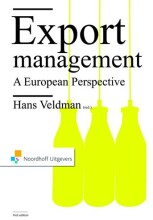Choosing an entry strategy - Indirect export
18 important questions on Choosing an entry strategy - Indirect export
Which methods are the most common employed in indirect export?
- The agent
- The importing re-seller and/or wholesale dealer
- The trading house/wholesale dealer
- Piggy-backing
- Joint selling
- The export combination
- The international joint venture
What must the agreement with an agent specify?
- The goods to which it applies
- The region (area)
- The conditions of exclusivity
- The clientele
- The rights and duties of the principal and the agent
- The agreement in restraint of trade
- Any possible secrecy
- The action to be taken in case of insolvent customers
- The conditions of sale
- The procedure for resolving conflict in law
- Industrial rights
- A guaranteed minimum income
- Etc.
What advantages and disadvantages are there when looking at an agent?
- Higher grades + faster learning
- Never study anything twice
- 100% sure, 100% understanding
Why is 'agent' the most popular form of distribution?
What is an importing re-seller and/or wholesale dealer?
What's the difference between an agent and a importer/re-seller (distributor)?
Name an disadvantage of an importer/re-seller (distributor)
Which four types of agreement with the importer may the exporter conclude?
- Distribution agreement (no limit competition)
- Exclusive re-selling agreement (exporter only sells to this re-seller)
- Exclusive purchase agreement (re-seller only buys from this exporter)
- Selective distribution agreement (only distributors who meet certain standards sell the products)
Name the advantages of a trading house/ wholesale dealer
- Quicker turnover on markets that are otherwise difficult to enter
- They know the local markets (savings on marketing costs)
- Greater chance of guaranteed turnover
- Because they know the local market, they are able to adapt to changes
Name the disadvantages of a trading house/ wholesale dealer
- No control over the turnover
- The exporter can't expect extra attention for certain products
Name the advantages of piggy-backing for the rider
- Lower costs
- Benefiting from carrier's market expertise
- Maximum control since he takes care of his own marketing plan
What is joint selling?
Name the advantages of joint selling
- Lower cost price
- Independence of the partners
- Few financial demands
- Quick access to the foreign market
Name a disadvantage of joint selling
What is an export combination?
This is a form of cooperation between a limited number of companies which, together, form a 'central body' to which the participating companies represent one or more export functions like:
- market research
- establishing contacts with agents, wholesalers and large customers
- making export marketing strategy
What is an international joint venture?
Why would companies choose for starting a joint venture?
- Fast entry into new markets
- Lowering of production costs
- The need to develop new technology
- Speeding up product introduction
- Avoiding legal and trade barriers
Name two disadvantages of a joint venture
- Often loss of control (can lead to loss of quality, high operating costs etc.)
- Legally complex
The question on the page originate from the summary of the following study material:
- A unique study and practice tool
- Never study anything twice again
- Get the grades you hope for
- 100% sure, 100% understanding
































